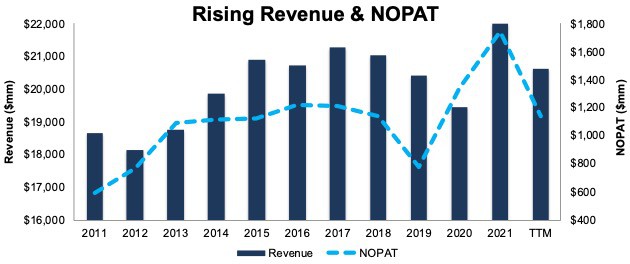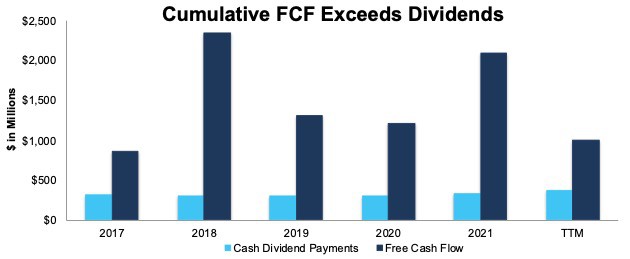Six new stocks made November’s Safest Dividend Yields Model Portfolio, which was made available to members on November 22, 2022.
Recap from October’s Picks
On a price return basis, our Safest Dividend Yields Model Portfolio (14.8%) outperformed the S&P 500 (+8.4%) by 6.4% from October 20, 2022 through November 18, 2022. On a total return basis, the Model Portfolio (+15.2%) outperformed the S&P 500 (+8.4%) by 6.8% over the same time. The best performing large-cap stock was up 22%, and the best performing small-cap stock was up 59%. Overall, 12 out of the 20 Safest Dividend Yield stocks outperformed their respective benchmarks (S&P 500 and Russell 2000) from October 20, 2022 through November 18, 2022.
This report leverages our cutting-edge Robo-Analyst technology to deliver proven-superior[1] fundamental research and support more cost-effective fulfillment of the fiduciary duty of care.
This Model Portfolio only includes stocks that earn an Attractive or Very Attractive rating, have positive free cash flow and economic earnings, and offer a dividend yield greater than 3%. Companies with strong free cash flow (FCF) provide higher quality and safer dividend yields because strong FCF is proof they have the cash to support the dividend. We think this portfolio provides a uniquely well-screened group of stocks that can help clients outperform.
Featured Stock for November: Whirlpool Corporation (WHR: $146/share)
Whirlpool Corporation (WHR) is the featured stock in November’s Safest Dividend Yields Model Portfolio.
Though Whirlpool’s profits have fallen from 2021’s all-time high, TTM NOPAT remains well above historical levels. Longer term, the company has grown revenue by 1% compounded annually and net operating profit after tax (NOPAT) by 6% compounded annually since 2011. Whirlpool’s NOPAT margin has risen from 3% in 2011 to 6% over the trailing twelve months (TTM), while return on invested capital (ROIC) has risen from 6% to 9% over the same time.
Figure 1: Whirlpool’s Revenue & NOPAT Since 2011
Sources: New Constructs, LLC and company filings
Free Cash Flow Supports Regular Dividend Payments
Whirlpool has increased its regular dividend from $4.30/share in 2017 to $5.45/share in 2021. The current quarterly dividend provides a 4.8% annualized dividend yield.
More importantly, Whirlpool’s free cash flow (FCF) easily exceeds its regular dividend payments. From 2017 to 2021, Whirlpool generated $7.9 billion (59% of current enterprise value) in FCF while paying $1.6 billion in dividends. Over the TTM, Whirlpool has generated $1.0 billion in FCF and paid out $380 million in dividends. See Figure 2.
Figure 2: Whirlpool’s FCF vs. Regular Dividends Since 2017
Sources: New Constructs, LLC and company filings
As Figure 2 shows, Whirlpool’s dividends are backed by a history of reliable cash flows. Dividends from companies with low or negative FCF are less dependable since the company may not be able to sustain paying dividends.
WHR Is Undervalued
At its current price of $146/share, Whirlpool has a price-to-economic book value (PEBV) ratio of 0.6. This ratio means the market expects Whirlpool’s NOPAT to permanently decline by 40%. This expectation seems overly pessimistic given that Whirlpool has grown NOPAT by 6% compounded annually since 2011 and 5% compounded annually since 2001.
Even if Whirlpool’s NOPAT margin falls to 5% (below its TTM NOPAT margin of 6%) and revenue falls by 1% compounded annually over the next decade, the stock would be worth $200+/share today – a 34% upside. See the math behind this reverse DCF scenario. In this scenario, Whirlpool’s NOPAT would fall by 5% compounded annually through 2031. Should the company’s NOPAT grow in line with historical growth rates, the stock has even more upside.
Critical Details Found in Financial Filings by Our Robo-Analyst Technology
Below are specifics on the adjustments we make based on Robo-Analyst findings in Whirlpool’s 10-Ks and 10-Qs:
Income Statement: we made $929 million in adjustments with a net effect of removing $39 million in non-operating income (<1% of revenue). Clients can see all adjustments made to Whirlpool’s income statement on the GAAP Reconciliation tab on the Ratings page on our website.
Balance Sheet: we made $8.8 billion in adjustments to calculate invested capital with a net increase of $1.1 billion. The most notable adjustment was $2.4 billion (20% of reported net assets) in other comprehensive income. See all adjustments made to Whirlpool’s balance sheet on the GAAP Reconciliation tab on the Ratings page on our website.
Valuation: we made $6.9 billion in adjustments with a net effect of decreasing shareholder value by $5.4 billion. Apart from total debt, one of the most notable adjustments to shareholder value was $763 million in excess cash. This adjustment represents 10% of Whirlpool’s market value. See all adjustments to Whirlpool’s valuation on the GAAP Reconciliation tab on the Ratings page on our website.
This article originally published on December 2, 2022.
Disclosure: David Trainer, Kyle Guske II, and Matt Shuler receive no compensation to write about any specific stock, style, or theme.
Follow us on Twitter, Facebook, LinkedIn, and StockTwits for real-time alerts on all our research.
[1] Our research utilizes our Core Earnings, a more reliable measure of profits, as proven in Core Earnings: New Data & Evidence, written by professors at Harvard Business School (HBS) & MIT Sloan and published in The Journal of Financial Economics.


